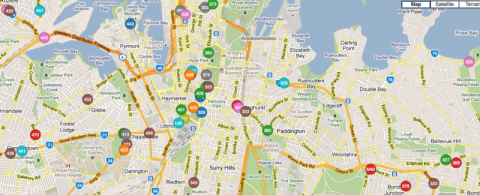Momentum is growing to construct a CBD to Randwick light rail line. It would join up to a proposed line running from Central to Circular Quay in the city. The recently elected Coalition government in NSW promised a feasibility study into it (along with an extension to the University of Sydney). It also now has the support of both the Sydney and Randwick councils, the University of NSW and Randwick Racecourse. The latter 3 have gotten together to fund a $300,000 pre-feasibility study, which will feed into the state government’s study, put up ads on bus shelters in the Randwick area supporting the project and set up a Light Rail To Randwick website.

The proposed route would go South from the city along Anzac Parade to UNSW, with an option for going East on High Street to the Prince of Wales Hospital and Royal Randwick shopping centre before heading North along Alison Road past Randwick Racecourse and connecting back to Anzac Parade. (Source: Light Rail To Randwick)
Within the governing Liberal Party, former head of the Prime Minister and Cabinet Department under John Howard, Max Moore-Wilton has also pushed for a light rail extension to Randwick as it could be completed relatively quickly. A fast tracked light rail could be ready by the next state election, whereas the current government’s major transport project (the Northwest Rail Link) may not be ready until early into a third term, if the government is still around by then.
Indeed, this seems like a rare occasion where the best policy is also the best politics. Commuters get a large increase in capacity between the city and Randwick, which is used both by residents going into the CBD and also by commuters going in the other direction towards Randwick Racecourse, the Prince of Wales Hospital, the University of NSW, Fox Studios, the SCG or the SFS. The government gets some runs on the board by delivering a key piece of transport infrastructure in the marginal electorate of Coogee which it picked up at the recent election.
You could argue that what the area really needs is an extension of the Eastern Suburbs Railway or a new underground heavy rail line going under Anzac Parade, either of which would provide higher capacity, greater speeds and better reliability than light rail. However, this would also come at a price, plus this is an area that will probably need both heavy rail and light rail at some point in the future. So for now it is better to build one with a view to building the other at some later date.



